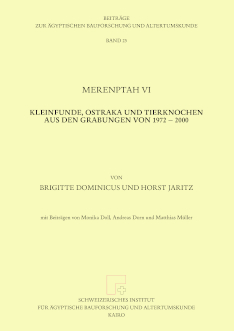
Brigitte Dominicus / Horst Jaritz
Merenptah VI.
Kleinfunde, Ostraka und Tierknochen aus den Grabungen von 1972 – 2000.
Beiträge zur ägyptischen Bauforschung und Altertumskunde, Band 25
Format: 35 x 24,5 cm – Hardcover
Umfang: 216 Seiten, 59 Abbildungen im Text, 7 Farbtafeln
ISBN: 978-3-935012-59-1
Preis: 85,00 €
© PeWe-Verlag 2023
In Ergänzung bisheriger Ergebnisse (Bände Merenptah II-V) der von 1971–2002 durchgeführten Nachuntersuchung des bereits von W. M. Flinders Petrie (1896) freigelegten Millionenjahrhauses des Merenptah in Theben/Luxor (Ägypten) berichtet der vorliegende Band von den im Zerstörungsschutt des Tempels und seinen Nebenanlagen gemachten Funden kleinerer Dimension.
Sie werden hier einer chronologischen, der Geschichte des Tempels folgenden Ordnung und zusammengefasst nach Art und Material vorgelegt.
Neben wenigen Funden aus der Zeit vor dem Bau des Tempels (Steinwerkzeuge, Siegelringe und gesiegelte Tonverschlüsse), stammt die Hauptmasse der Funde aus der Zeit, als der Kultbetrieb im Tempel andauerte (Opferständer, Krugverschlüsse, Gegenstände aus Fayence, Glas und Stein, Modeln zur Herstellung von Amuletten, Perlen, Lampen). Sie werden eingeführt von Funden aus der Zeit der Tempelerrichtung (Werkzeuge und andere Hilfsmittel), nachgefolgt von denen seiner Nachnutzung vor allem als Steinbruch (Halbfertigprodukte, Werkstücke und Gefäße aus Kalkstein). Einen breiten Raum nehmen die Ostraka und dockets ein, ebenso die Vielzahl der im Tempel verstreuten Tierknochen.
Darüberhinaus gibt es wenig Funde einer Nachbesiedlung des Tempels, dagegen eine größere Anzahl von Objekten (Grabstelen, Grabkegel, Toilettengegenstände, Gefäße aus Alabaster und Fayence), die ihren Weg offenbar aus der thebanischen Nekropole in den Tempel fanden.
Mit Beiträgen von Monika Doll, Andreas Dorn und Matthias Müller.
In addition to preceding results (vols. II-IV) of the re-investigated House of a Million of Years of Merenptah at Thebes /Luxor (Egypt), which was already excavated by W. M. Flinders Petrie (1896), the present volume reports on the finds of smaller dimensions, found in the debris covering the area of the temple and its adjacent mudbrick-buildings.
The sequence of the presented objects follow the chronological development of the temple and are grouped according to type and material.
Apart from a few finds preceding the temple’s foundation (prehistoric tools, signet rings, clay sealings), the majority of the objects dates to the time of the acting cult (offering stands, jar stoppers, objects made of faience, glass and stone, models for the production of amulets, beads, lamps). They are introduced by objects from the time of the temple’s construction (various tools), followed by those from the period when the temple was abandoned and mainly used as a quarry (semi-finished products, limestone workpieces and vessels). Ostraca and dockets cover a major part of the volume, as does the many animal bones scattered over certain areas of the temple.
In addition, there are few finds of a later settlement in the temple, but a large number of other objects (stelae, funerary cones, cosmetic items, vessels made of alabaster and faience), which apparently found their way from the Theban necropolis into the temple.
With contributions by Monika Doll, Andreas Dorn and Matthias Müller.